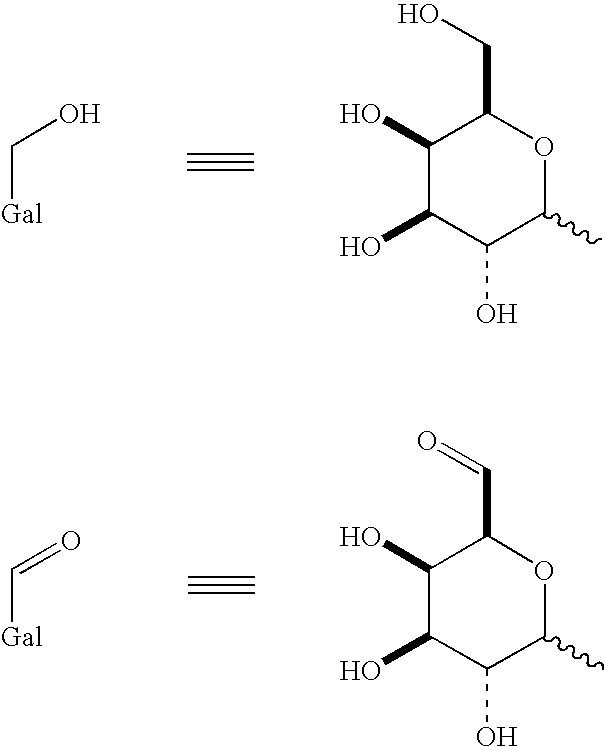Use of galactose oxidase for selective chemical conjugation of protractor molecules to proteins of therapeutic interest
a technology of protractor molecules and galactose oxidase, which is applied in the direction of peptide/protein ingredients, unknown materials, plant/algae/fungi/lichens ingredients, etc., can solve the undesirable short in vivo plasma half-life of certain therapeutically useful glycoproteins, prolong the circulating half-life of such glycoproteins, and reduce the quantity of injection material
- Summary
- Abstract
- Description
- Claims
- Application Information
AI Technical Summary
Benefits of technology
Problems solved by technology
Method used
Image
Examples
specific embodiments
[0121] Specific embodiments of R-nuc, which is PEG-2-40K derivatives is shown in the following by illustration and not limitation:
[0122] In one embodiment of the invention, the reactant X has the formula nuc-R, wherein nuc is a functional group which can react with an aldehyde to form a covalent bond, and R is a PEG group. In one embodiment of the invention, the nuc-R is selected from the group consisting of:
wherein mPEG has a molecular weight of 20 kDa,
wherein mPEG has a molecular weight of 20 kDa,
wherein mPEG has a molecular weight of 20 kDa,
wherein mPEG has a molecular weight of 20 kDa,
wherein mPEG has a molecular weight of 20 kDa,
wherein mPEG has a molecular weight of 20 kDa,
wherein mPEG has a molecular weight of 20 kDa,
wherein mPEG has a molecular weight of 20 kDa,
wherein mPEG has a molecular weight of 20 kDa,
wherein mPEG has a molecular weight of 20 kDa,
wherein mPEG has a molecular weight of 20 kDa,
wherein mPEG has a molecular weight of 20 ...
example 1
O-(N,N-Diethylaminoethyl)hydroxylamine
[0292]
[0293] N-hydroxyphthalimide (10.0 g, 62.5 mmol) was dissolved in THF (100 ml) and potassium carbonate (18.63 g; 0.134 mol) was added. Diethylaminoethylchloride (10.54 g; 61.5 mmol) was added and the mixture was heated to reflux for 4 h. The mixture was cooled and added water (100 ml) and stirred until all solid had dissolved. The mixture was then extracted twice with DCM. The organic phase was dried with anhydrous sodium sulphate and evaporated to give 8.63 g (53%) of N-(N,N-diethylaminoethoxy)phthalimide as a clear yellow oil. The oil was dissolved in a minimum of acetonitril and 1.1 equivalent of 1N HCl in ethylacetate was added to precipitate N-(N,N-diethylaminoethoxy)phthalimide hydrochloride. 1H-NMR (D2O): δ 1.24 ppm (t, 6H); 3.28 (m, 4H); 3.56 (t, 2H); 4.45 (t, 2H); 7.72 (s, 4H). 13C-NMR (D2O): δ 8.25 ppm; 47.93; 50.46; 72.10; 124.27; 128.34; 135.81; 165.82. N-(N,N-diethylaminoethoxy)phthalimide hydrochloride (2,50 g; 8.37 mmol) was...
example 2
3-[(2-Aminooxyacetyl)-(2-carboxyethyl)amino]propionic acid
[0294]
[0295] 3-Aminopropionic acid tert-butyl ester hydrochloride (7.27 g. 40 mmol) was dissolved in DMF (40 ml). Triethylamine was added (4.05 g, 40 mmol). A solution of tert-butyl acrylate (5.13 g, 40 mmol) in DMF (40 ml) was added to the solution under inert atmosphere. After stirring at rt for 16 h, the precipitate was filtered off, and the filtrate is concentrated, dissolved in ethyl acetate (100 ml), washed with sat. NaHCO3 (2×50 ml), dried over MgSO4 and concentrated. The oil was purified by vacuum distillation (0.02 torr, 103-107° C.) to yield 3-(2-tert-butoxycarbonylethylamino)propionic acid tert-butyl ester as a colorless oil (4.7 g, 43% yield). 1H-NMR (CDCl3): δ 1.45 ppm (s, 18H), 2.41 (t, J=6.4 Hz, 4H), 2.84 (t, J=6.5 Hz, 4H). LCMS: m / z=274 (M+1), Rt=2.41 min.
[0296] 3-(2-tert-Butoxycarbonylethylamino)propionic acid tert-butyl ester (0.63 g, 3.07 mmol), N-tert-butoxycarbonyl aminooxyacetic acid (1.07 g 5.27 mmol)...
PUM
| Property | Measurement | Unit |
|---|---|---|
| molecular weight | aaaaa | aaaaa |
| molecular mass | aaaaa | aaaaa |
| molecular weight | aaaaa | aaaaa |
Abstract
Description
Claims
Application Information
 Login to View More
Login to View More - R&D
- Intellectual Property
- Life Sciences
- Materials
- Tech Scout
- Unparalleled Data Quality
- Higher Quality Content
- 60% Fewer Hallucinations
Browse by: Latest US Patents, China's latest patents, Technical Efficacy Thesaurus, Application Domain, Technology Topic, Popular Technical Reports.
© 2025 PatSnap. All rights reserved.Legal|Privacy policy|Modern Slavery Act Transparency Statement|Sitemap|About US| Contact US: help@patsnap.com



